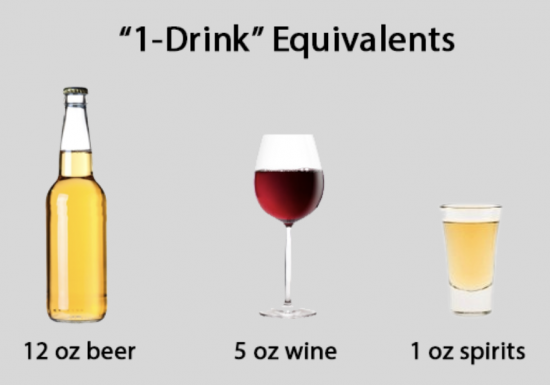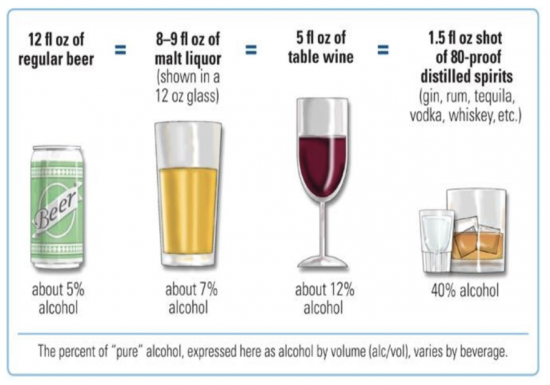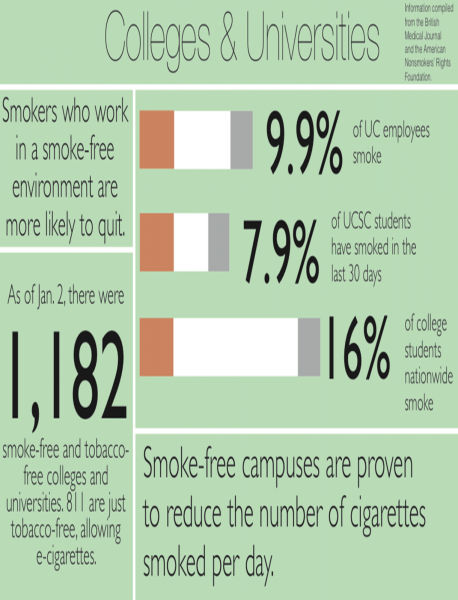Alcohol & Other Drugs
Decisions about substance use are personal. It’s your right and responsibility to make decisions for yourself. If, how often and how much you drink or use other drugs are your choices. Your best bet is to make informed choices and understand potential consequences.
Alcohol Basics
Let’s define a drink….


How Many Drinks Are in Your Drink?
Sometimes students will take cups and drink out of a ‘common source’ – a large, unmarked container, such as a punchbowl, trough or even a lined trash barrel. Besides the sanitary concerns, drinking from these kinds of containers is dangerous because students don’t know how much alcohol is in their cup. Adding to the hazardousness, these concoctions tend to be fruity and/or sweet to hide the taste of the alcohol, and it may be mixed with energy drinks. Ingredients in energy drinks are unsafe to mix with alcohol because the stimulant effect of the energy drink gives drinkers a false sense of how intoxicated they are getting. Avoid drinking from these ‘common sources’.
High Risk And Low Risk Drinking
- Chugging
- Drinking out of punch bowls, troughs, hoses or funnels
- Drinking to get drunk
- Driving after drinking or riding with someone who is under the influence of alcohol and other drugs
- Drinking too much too fast
- Not knowing what is in your glass
- Mixing alcohol with medications or illegal drugs
- Drinking because you feel your social group wants you to drink
- Drinking Games
- Before the party, thinking about if you will drink and set a limit of what you will drink
- Eating a full, hearty meal before drinking
- Drinking no more than one drink per hour
- Always knowing what you’re drinking
- Alternating alcohol-free drinks over the evening
- Planning how to get home safely
- Using a “buddy” system so no one is left alone
- Trusting your instincts
A Word About Other Drugs
Tobacco accounts for one out of every 10 deaths world wide and claims nearly 6 millions lives each year. The Office of Student Wellness and Health Promotion can provide support students in their pursuit of tobacco cessation through Wellness Coaching. Complete this form to make a request for Wellness Coaching.
More Information
Blood Alcohol Concentration is the percentage of your blood volume that is alcohol. If you choose to drink, the safest option is to know how much alcohol your drink contains and limit the amount of alcohol you are consuming within a given time frame.
- A BAC below 0.05 enables a drinker to feel the positive effects of alcohol without minimizing their judgment or increasing their risk of negative outcomes.
- Pace and Space: sip your drink, alternate with non-alcoholic beverages, and don’t drink more than 1 standard drink per hour.
- Eat before and while drinking: having food in your stomach slows the rate at which alcohol is absorbed into your bloodstream.
- Don’t mix alcohol with other drugs or medications.
- Are you sick or tired? If so, know that your body will metabolize alcohol more slowly.
- Beyond .05 BAC is when a person will experience more unpleasant and usually unwanted effects of alcohol use including impaired judgment, loss of coordination, slurring speech, blackouts, vomiting or alcohol overdose.
Visit the B4U Drink Educator. This website, designed by The Century Council (funded by distillers), includes a Virtual Bar where you can estimate your BAC before you go out. Virtual Bar
An alcohol overdose is a MEDICAL EMERGENCY. It is important to call for help right away if you see any of these signs of alcohol overdose:
- Irregular breathing (8 breaths a minute or 10 seconds or more between any two breaths)
- Vomiting while passed out and they don’t wake up while vomiting or afterward
- Skin is pale, cold and/or bluish-purple
- Person is unresponsive to pinching
Call 911 or Campus Safety and Security. Don’t wait. Every minute is critical.
At times, you may become concerned about your own or a friend’s use of alcohol or other drugs. Problematic use of substances can affect a person’s academics, relationships, and mental and physical health. A party culture that involves heavy alcohol or other drug consumption can have a negative impact on the larger campus community. There is no specific measurement to determine when substance use becomes “too much” and crosses over the line from social to unhealthy. However, the following signs may indicate that a problem exists; the greater the number of signs on the list, the greater the concern.
Signs that someone may be having a problem with alcohol or other drugs:
- Daily functioning is impaired, e.g. hygiene, class or work attendance or performance, relationships, attention and memory, etc.
- The student or someone else has expressed concerns about their use
- The student appears to be under the influence while in class or at work
- The student or someone else has been injured as a result of their substance use
- The student has encountered legal or disciplinary problems as a result of their substance use
- The student has experienced blackouts or brownouts (memory lapses) as a result of their substance use
- The student engages in high-risk behaviors, such as binge drinking, drinking and driving, having unprotected sex under the influence, etc.
- The student expresses guilt or remorse about their substance use or behavior when under the influence
- The student seems preoccupied with alcohol/drug use, e.g. when they will next drink/use
- The student seems reliant on alcohol or drugs, e.g. drinks in the morning, can’t go without smoking for a day, “has to” drink or get high in social situations, etc.
- The student has an increase in drug tolerance (they need more of the drug to achieve the same effect as they did at lesser amounts).
- The student is mixing two or more drugs when they “party”.
Even one night of heavy drinking can affect a person’s learning and memory retention for up to 48 hours. For example, if you drink on a Saturday night in hopes of cramming all day Sunday for an exam on Monday, your brain will still be recovering from the effects of Saturday night while you are sitting in class on Monday.
Alcohol use also interferes with the body’s sleep cycle, robbing you of necessary REM sleep. The results include the foggy-headed feeling of a hangover, as well as fatigue and irritability the next day.
Academic performance and AOD Use Resources:
College Academic Performance and Alcohol and Other Drug Use
How Do Drugs and Alcohol Impede Students’ Academic Progress?
Alcohol and Other Drug Use and Academic Achievement
Medications taken without a prescription, and illegal drugs, such as marijuana, can have many adverse effects on students. Students are strongly encouraged to resist engaging in these activities. A person’s behavior may become erratic when using these substances.
Though medical marijuana was approved in Massachusetts in 2012, its possession and use is not legal on campus due to it being against federal law. Schools that receive federal funding (for financial aid, for research grants, etc.) need to adhere to federal laws.
Students who are on medications have been evaluated by a medical professional, and oftentimes, have tried a few different kinds and dosages of drugs to most closely correct the student’s condition with fewer negative side effects. Taking someone else’s prescription medication is illegal and risky, and the results may be unpredictable at the very least, and can be fatal in some cases.
To save more lives from drug overdose, the Centers of Disease Control and Prevention (CDC) recently launched four complementary education campaigns intended to reach young adults ages 18—34 years. The campaigns provide information about the prevalence and dangers of fentanyl, the risks and consequences of mixing drugs, the life-saving power of naloxone (Find Naloxone), and the importance of reducing stigma around drug use to support treatment and recovery.
CDC spoke directly with young adults who reported using drugs, as well as peer recovery professionals, to develop the campaigns. Each campaign includes new resources on all four topics to help people make informed decisions, get the help they need, and ultimately reduce the rise in drug overdoses and overdose deaths.
“This critical information can help all of us save a life from overdose and support people who use drugs in treatment and recovery,” said Debra Houry, MD, MPH, acting principal deputy director of CDC.
Fentanyl Can be Hidden in Drugs
Illegal drugs are more potent and potentially lethal than ever before as many can be mixed or laced with illicitly made fentanyl without a person’s knowledge. Fentanyl, an extremely powerful synthetic opioid that is up to 100 times stronger than morphine, and other synthetic opioids contribute to most opioid-involved overdose deaths. Illicitly made fentanyl is increasingly found in counterfeit prescription medications, heroin, cocaine, methamphetamine, and other illicit drugs. It is nearly impossible to tell if drugs have been laced with fentanyl without the use of fentanyl test strips because it cannot be seen, smelled, or tasted.
Mixing Drugs Can Cause Overdoses
People who use drugs may use multiple different substances, and this mixing of drugs can be even more harmful than when they are used separately. Mixing stimulants—like ecstasy and cocaine—increases the risk of stroke and heart attack, while mixing opioids with other depressants—like benzodiazepines (“benzos”) and/or alcohol—can slow breathing, which may lead to severe brain damage or death. Bottom line, there is no safe way to mix drugs. Even if you have mixed drugs before, your body could react differently every time.
Naloxone Saves Lives
Naloxone is a life-saving medicine that can reverse an opioid overdose. Often given as a nasal spray, naloxone can restore normal breathing to a person whose breathing has slowed or stopped due to opioids, including fentanyl, if given in time. Anyone can carry naloxone, give it to someone experiencing an overdose, and potentially save a life.
Naloxone is available in all 50 states and Washington, DC, and it is available at many local pharmacies without a prescription in most states. Good Samaritan laws are in place in most states external icon to protect those who are overdosing and anyone assisting them in an emergency from arrest, charges, or a combination of these. Find Naloxone
People in Treatment and Recovery Need Support
One in 14 Americans reports experiencing a substance use disorder. However, the stigma related to using drugs can be a significant barrier to getting help. Showing compassion for people who use drugs and offering support during their treatment and recovery journey are ways to help reduce stigma. Paths to recovery include treatment with medications for opioid use disorder, as well as behavioral therapies. Treatment is available in many settings—in person, online, through telehealth visits, –treatment can be in individual or group formats.
“Addiction is a treatable disease,” said Christopher M. Jones, PharmD, DrPH, MPH, acting director of CDC’s National Center for Injury Prevention and Control. “And while recovery is not always a straight path forward, it is possible. Talking with a healthcare provider to develop a treatment plan that works best for that individual and connecting to other services and supports can aid recovery.”
Last updated: 3/18/2022


